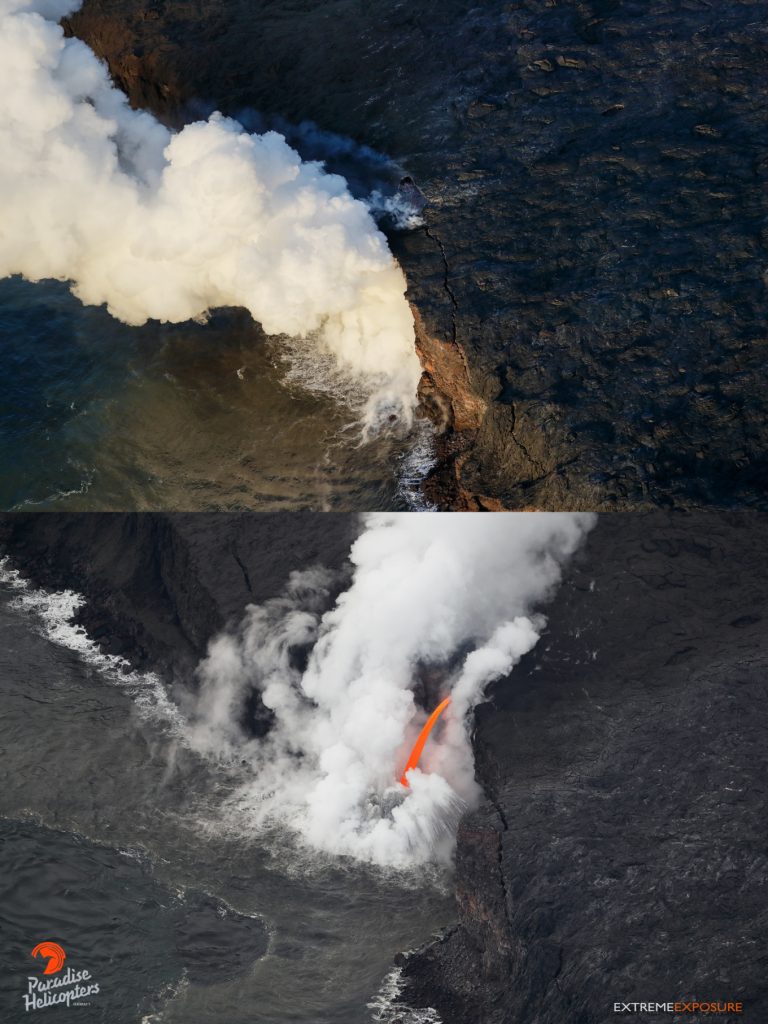Volcano Overflight: Fire Hose Lava Flow
Feb. 2, 2017: Kī hō’alu (Hawaiian slack key guitar) by Hilo’s Ben Kaili.
A magnificently clear day allowed the crew of Paradise Helicopters to access the Pu‘u ‘Ō‘ō vent on the morning of Thursday, Feb. 2, 2017, capturing images of a very active lava lake.
Skylights just east of the vent were accessible, but the crew was unable to see inside. This conduit feeds not only the ongoing 61g flow but also the two still active additional flows on top of the tube system and just to the northeast of 61g, which is now 1.5 miles from the vent.
Pele still breaks out there, but both of these flows are sluggish, to say the least, and may well be dying,” said Tropical Visions Video photographer and videographer Mick Kalber. The main flow continues unabated, dumping between one and two million gallons of hot rock into the Pacific Ocean every hour.”
The ocean entry is still at Kamokuna, just inside Hawai‘i Volcanoes National Park.
“Pele’s liquid rock flows through the tube system from the vent some six miles to the new lava delta, which continues to make the Big Island bigger,” said Kalber. “But several recent collapses have lopped off sizable portions of the bench and sea cliff at the entry area.”
Kalber reported that a long-lived firehose lava stream continues there, sometimes visible and sometimes not.
“Today, we documented littoral explosions, but saw no lava,” said Kalber.
“The ocean entry remains a magnificent sight for visitors who can gain access from either the Kalpana of HVNP side by walking out the temporary access road, which goes directly to the ocean entry,” Kalber said.
The walk is lengthy and precautions should be observed.
To reach the new lava viewing area within Hawai‘i Volcanoes National Park from the east (Kalapana-side), visitors must hike about 4.2 miles one way along the gravel emergency access road. This entrance is open daily from 3 p.m. to 9 p.m. From the park, or west side, visitors can hike out from the Coastal Ranger Station at the end of Chain of Craters Road, about five miles one-way. About one mile of the hike goes inlandof the gas plume over hardened, uneven lava flows. The park entrance is open 24 hours a day.
Hikers need to be prepared for a long trek. Wear sturdy closed-toe shoes or boots, gloves to protect the hands, and long pants to protect against lava rock abrasions. Carry plenty of water (three to four quart/liters per person). Wear sunblock, sunglasses and a hat. Visitors who plan to stay after dark need a flashlight and/or headlight with extra batteries.
Download hiking tips here.

In the before image (top), the location of the skylight, where steam is rising from the crack, is approximately where the lava is now exiting the tube and free falling into the sea. The before image were shot at 7 a.m., Feb. 2; the after image was shot at 4 p.m., Feb. 3. ExtremeExposure photo.
















